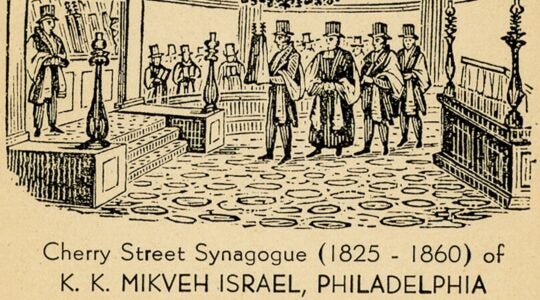WALTHAM, Mass. (JTA) — Eighty-five years ago, in 1924, two wealthy and accomplished Jewish college students, Nathan F. Leopold and Richard A. Loeb, motivated by Nietzchean philosophy and determined to commit the “perfect crime,” brutally murdered 14-year-old Bobby Franks in Chicago.
Shocked B’nai B’rith leaders in Mobile, Ala., wrote to the national secretary of B’nai B’rith, Leon Lewis, expressing interest in the case and wondering what the Jewish organization’s response would be. The answer, in one word, was “Hillel.”
The new campus organization, whose establishment Lewis characterized as “almost providential,” would henceforward provide Jewish students with precisely the kind of initiation into Jewish communal life that Leopold and Loeb never had. Wisely, B’nai B’rith adopted Hillel in 1925 and sponsored the organization for nearly 70 years.
Hillel, which continues its 85th anniversary year celebrations this summer, began independently in 1923 at the University of Illinois, Champaign-Urbana, and focused from the start on winning over assimilated Jewish college students.
“The average student is sick and tired of hearing about the glorious past of our people,” a Hillel executive reported in 1928. “He wants to have definite advice as to sex morality, about Jewish home life, his attitude toward his girl, etc. Unless we can give him that conception, make him understand that any sort of Jew is accepted, that we do not classify the Jews as Orthodox or Reform, then we have failed.”
Under the direction of Abram Sachar, later the founding president of Brandeis University, Hillel expanded, growing to more than 100 units at universities across North America. Many of these, significantly, opened during the dark days of the Depression when (as now) higher education seemed to many Jews a more sensible alternative to unemployment. Since Jews faced significant social discrimination on college campuses in those days, Hillel provided them with a refuge, a home away from home. It strove to meet their social, cultural and religious needs.
Following World War II, thanks in part to the G.I. Bill, the number of Jews on college campuses mushroomed. The American Jewish community’s interest in campus affairs, meanwhile, waned. As B’nai B’rith support for Hillel diminished, Hillel professionals — fatefully — concentrated their attention on the minority of involved Jewish students. For the rest, Hillel became irrelevant.
Underfunded and passive, Hillel was ill prepared to weather the cultural and political storm of the 1960s.
“In an age when students protest against the establishment, Hillel is the symbol of the establishment,” Rabbi Edward Feld, then Hillel director at the University of Illinois, complained.
Rabbi Irving Greenberg characterized the American college campus as a “disaster area for Judaism, Jewish loyalty and Jewish identity.”
By the 1970s, Hillel was admitting defeat.
“We are doing our job poorly in some places,” its national director, Alfred Jospe, confessed. “We continue to have utterly inadequate and sometimes virtually nonexistent program budgets.
Jospe went on to note that with “a staff-student ratio of one to 2,000 or one to 3,000 or even one to 5,000,” Hillel is “cruelly underfunded.”
The 1988 appointment of Richard Joel as international director began Hillel’s modern-day revival. During the course of his tenure, Joel remade, re-energized and repackaged the organization. Exploiting communal concerns over “Jewish continuity,” he reminded Jewish leaders that “the campus is … a key gateway for Jewish continuity and a key definer of the Jewish future.”
Under his leadership, Hillel became an independent organization, reached more students than ever and raised unprecedented sums.
Today, guided by President Wayne Firestone, Hillel has adopted a new mission statement and strategic plan that commits the organization to “enriching the lives of Jewish undergraduate and graduate students so that they may enrich the Jewish people and the world.”
Through Taglit-Birthright Israel trips, social justice alternative breaks and on-campus educational initiatives, Hillel strives to infuse Jewish meaning into the lives of the most uninvolved Jewish students. Hillel has returned to its roots as an organization committed to those lacking a Jewish education while still providing outlets for more Jewishly committed students.
Hillel celebrates its anniversary at a moment when the largest group of Jewish students in American history — the children of the baby boomers — is reaching college campuses. Meanwhile, the Jewish community’s funding sources, drained by the economic downturn and the Madoff scandal, are dramatically shrinking. As communities everywhere reassess their priorities, the needs of Jewish college students need to be remembered.
Eighty-five years after the Leopold and Loeb case brought the needs of Jewish college students to the community’s attention, Hillel’s mission is more urgent than ever.
(Jonathan D. Sarna is the Joseph H. & Belle R. Braun Professor of American Jewish History at Brandeis University and author of “American Judaism: A History.”)
JTA has documented Jewish history in real-time for over a century. Keep our journalism strong by joining us in supporting independent, award-winning reporting.






